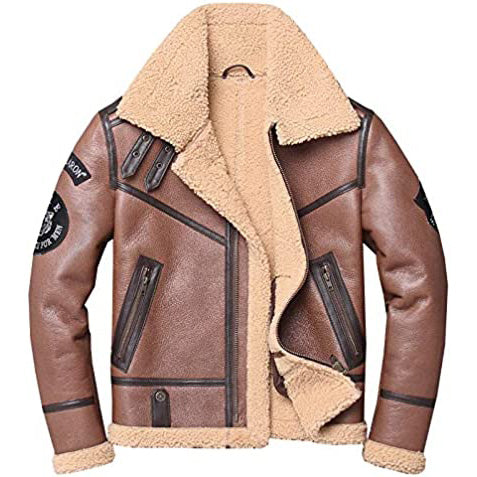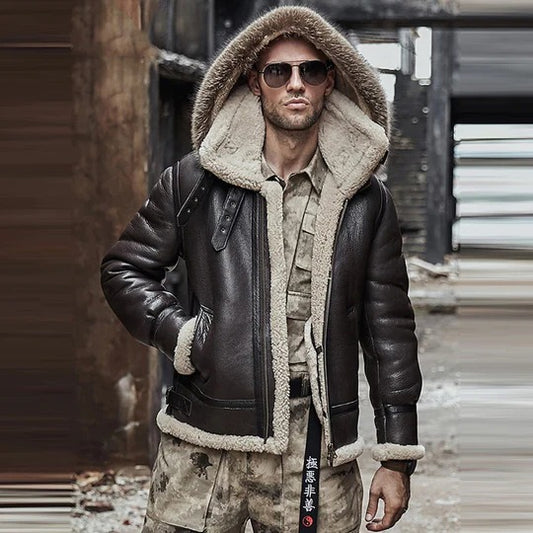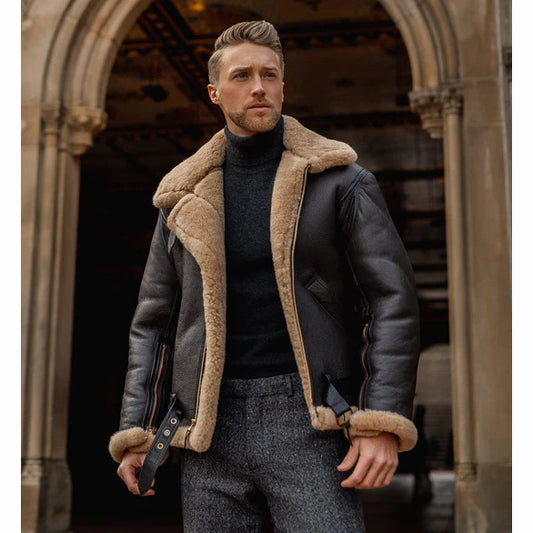What Is the Safest Leather? A Comprehensive Guide
Leather has long been a symbol of durability, luxury, and style. Whether it's jackets, bags, or shoes, leather products are often chosen for their strength and aesthetic appeal. However, when it comes to choosing leather, many people wonder: what is the safest leather? This question is particularly important for those looking for leather that's not only durable but also eco-friendly, non-toxic, and ethically sourced.
In this comprehensive guide, we'll dive into the factors that make leather safe, explore the different types of leather, and offer expert opinions on the safest leather options. By the end, you'll have a clearer understanding of what to look for when purchasing leather products, especially from brands like Jackets Kingdom.
Understanding What Makes Leather Safe
Before exploring the safest types of leather, it's important to define what "safe" means in the context of leather production and usage. Safety in leather refers to several factors:
- Chemical-Free Processing: Leather is often treated with chemicals like chromium during tanning. However, vegetable-tanned leather, which uses natural tannins from plants, is considered safer.
- Non-Toxic Dyes: Some leathers are dyed using harmful chemicals. Safer leather options use natural or non-toxic dyes.
- Durability: High-quality leather is less prone to wear and tear, reducing the need for replacements and minimizing waste.
- Sustainability: Leather that is responsibly sourced from animals raised ethically or produced using eco-friendly methods is safer for the environment.
Types of Leather and Their Safety Levels
There are several types of leather available, each with its own pros and cons in terms of safety, durability, and environmental impact. Here are the most common ones:
Full-Grain Leather
What It Is: Full-grain leather is made from the top layer of the hide and is the most durable and highest-quality leather available.
Safety Level: Full-grain leather is often vegetable-tanned, making it a safer option in terms of chemical exposure. It is also incredibly durable, which reduces the environmental impact by lowering the need for frequent replacements. This leather retains the natural grain, making it breathable and less likely to trigger allergies.
Expert Opinion: "Full-grain leather is the gold standard in leather safety. Its natural processing makes it a healthier and more eco-friendly choice," says Sarah Levine, a leather goods expert at Jackets Kingdom.
Top-Grain Leather
What It Is: Top-grain leather is the second layer of the hide. It undergoes sanding and buffing to remove imperfections, making it softer but slightly less durable than full-grain leather.
Safety Level: Top-grain leather is often treated with more chemicals than full-grain leather. However, choosing vegetable-tanned or water-based dye-treated top-grain leather can minimize safety concerns.
Expert Opinion: "While top-grain leather is a good alternative to full-grain, it's important to opt for vegetable-tanned varieties to avoid chemical exposure," says leathercraft specialist Mark Ritter.
Suede and Nubuck
What It Is: Suede is made from the underside of the hide, while nubuck is top-grain leather sanded on the grain side.
Safety Level: Suede and nubuck are more prone to damage, which can shorten their lifespan. They also require chemical treatments for water and stain resistance, which may impact safety.
Expert Opinion: "Both suede and nubuck are beautiful, but they require significant maintenance and often involve chemical treatments that aren’t as safe," explains Rita Moore, a sustainable fashion expert.
Bonded Leather
What It Is: Bonded leather is made from leftover scraps of leather that are bonded together with adhesives.
Safety Level: Bonded leather is not considered safe, as it often contains a high level of chemicals and synthetic materials. It is also less durable and tends to break down quickly.
Expert Opinion: "Avoid bonded leather if you’re looking for a safe, long-lasting product. It’s cheaper, but the quality and safety just aren’t there," advises Rita Moore.
The Importance of Leather Sourcing
Where your leather comes from plays a significant role in its safety. Ethically sourced leather, often referred to as "sustainable leather," comes from animals that are raised in humane conditions. This not only ensures the quality of the leather but also minimizes environmental harm.
Additionally, some leather is made from byproducts of the food industry, ensuring that no part of the animal goes to waste. Opting for sustainable brands like Jackets Kingdom, which prioritize ethical sourcing, is a great way to ensure you’re choosing safe leather.
Leather Tanning Methods: The Key to Safety
Leather tanning is the process used to turn animal hides into durable material. The method used in tanning can dramatically affect the safety of the leather:
Chrome Tanning
Process: Chrome tanning uses chromium salts, which speed up the tanning process.
Safety Concerns: Chrome tanning is quicker and cheaper, but it often leaves behind traces of toxic chromium in the leather, which can pose health risks.
Expert Insight: "Chrome-tanned leather should be avoided when safety is a priority. Vegetable-tanned leather is a much safer option," advises John Davis, a leather chemist.
Vegetable Tanning
Process: Vegetable tanning uses natural tannins from plants, bark, and other organic materials.
Safety Benefits: This method is not only safer for the environment but also results in leather that is chemical-free and more breathable.
Expert Insight: "For anyone concerned about health and safety, vegetable-tanned leather is the way to go. It’s durable, eco-friendly, and free from harmful chemicals," says Sarah Levine.
Why Eco-Friendly Leather Is Safer
Eco-friendly leather is produced with minimal environmental impact. These leathers are often tanned using natural methods and dyed using water-based or natural dyes.
Benefits of Eco-Friendly Leather:
- Lower Chemical Exposure: Less toxic chemicals are used, making it safer for wearers.
- Sustainable Practices: Eco-friendly leather is often produced using sustainable methods, which can help reduce your carbon footprint.
Expert Opinion: "Eco-friendly leather isn’t just about protecting the environment; it’s also about protecting yourself from the harmful effects of chemicals often found in traditional leather," notes green fashion consultant Emily Wright.
The Safest Leather for Jackets: A Buyer’s Guide
When it comes to leather jackets, safety is paramount. Whether you're riding a motorcycle or just looking for a stylish addition to your wardrobe, here’s what to look for:
- Durability: Full-grain or vegetable-tanned leather is best.
- Breathability: Opt for leather that is breathable to avoid skin irritation.
- Allergy-Free: Ensure that the leather is free from chrome or other heavy metals to avoid allergic reactions.
At Jackets Kingdom, all our leather jackets are made from ethically sourced, vegetable-tanned leather, offering the perfect combination of style, safety, and durability.
Caring for Your Leather: Safety and Longevity
Proper leather care not only extends the life of your products but also maintains their safety. Here are some tips:
- Use Natural Conditioners: Avoid chemical-based conditioners that can damage the leather over time.
- Avoid Excessive Water: Water can weaken the leather's fibers, so always dry your leather items properly.
- Store Correctly: Leather should be stored in a cool, dry place to avoid mold or mildew.
Expert Advice: "A high-quality leather product can last a lifetime if cared for properly. Always choose products free from harmful chemicals and use natural products for maintenance," suggests John Davis.
Frequently Asked Questions (FAQs)
What is the safest leather for sensitive skin?
Vegetable-tanned leather is the safest for sensitive skin due to its natural tanning process, which avoids harmful chemicals.
Is chrome-tanned leather toxic?
Chrome-tanned leather can contain traces of toxic chromium, which may pose health risks, particularly for those with allergies.
What is eco-friendly leather?
Eco-friendly leather is produced using sustainable practices, often avoiding harmful chemicals and reducing environmental impact.
How can I tell if leather is safe?
Check the tanning process. Leather that is vegetable-tanned or tanned using natural methods is generally safer.
Where can I find safe leather jackets?
Look for brands like Jackets Kingdom, which offer vegetable-tanned, ethically sourced leather jackets.
Conclusion: The Safest Leather for a Healthier, More Sustainable Choice
Choosing the safest leather doesn’t just benefit you; it also benefits the environment. Whether it’s opting for full-grain, vegetable-tanned leather or ensuring your leather comes from sustainable sources, the choices you make matter. Brands like Jackets Kingdom are leading the way by offering high-quality, ethically sourced leather products that prioritize both safety and style.
Remember, safe leather is durable, free from harmful chemicals, and sourced responsibly. By choosing the right leather, you’re making an investment in both your health and the planet.




